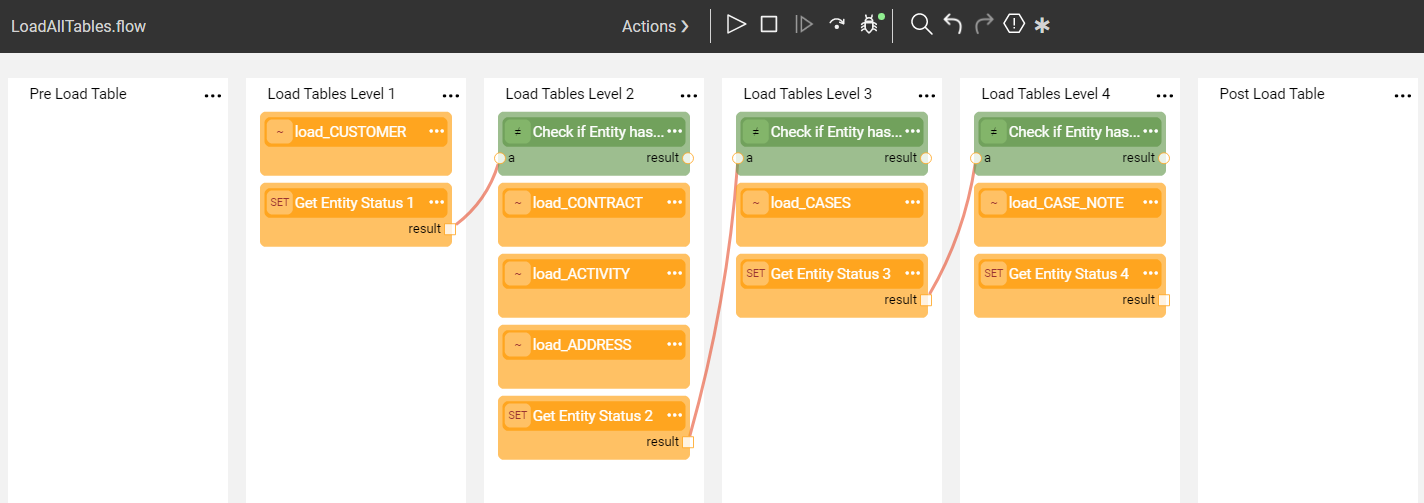TDM Implementation - Supporting Non JDBC Data Sources
How Do I Define the Entity List?
Extract All Entities Tasks
Create a Broadway flow to get the list of entities from the data source and populate it in the trnMigrateList translation.
For more information on how to populate the entity list based on a non JDBC data source, read Step 6 -Get the Entity List for an Extract All Task Using a Broadway Flow section of the Broadway Flows Implementation article.
Using Custom Logic to Select Entities
Create Broadway flows to be executed by the task execution and get the entity list for the task.
For more information on how to build Custom Logic flows, read Step 7 - Optional - Build Broadway Flows for the Custom Logic Selection Method.
Building the LU Tables Populations
Step 1- Main Source LU Table
The population of the main source LU table must be generated based on populationRootTable.pop.flow template imported from the TDM Library:
- Right click the table name > New Table Population Flow From Template > populationRootTable.pop.flow. A popup window is opened.
- Populate the popup window's settings as follows:
- File Name: populate the file name by [LU Table Name].[flow name]
- Do not populate the TABLE_NAME , KEY, and the SOURCE_INTERFACE parameters when populating the main source LU table based on a non JDBC data source.
- The generated flow is created with an empty source query in the Source stage. Replace the empty sourceDbQuery in the Source stage by the updated actor to extract the data from the data source and link it to the main source LU table in the LU Table stage.
Step 2 - Other LU Tables
Create Broadway flows to populate the other LU tables.
Building the Broadway TDM Flows
Step 1- Build Load and Delete Flows
The createLoadTableFlows and createDeleteTableFlow flows call the getDbTables function to get the target JDBC structure and therefore cannot be used for a non JDBC target. Therefore the load and delete flows need to be created manually:
A separate load flow for each target object. The data is taken from the related LU table. Add sequence and masking handling if needed.
A separate delete flow of each target object. The target keys are taken from the TAR_ LU tables.
LoadAllTables flow: this flow executes the inner load flows on each target object in the correct order.
See an example below:

The Get Entity Status actors check the ENTITY_STATUS value and the flow runs the load flows of the next stage if the ENTITY_STATUS is not failed.
DeleteAllTables flow: this flow executes the inner delete flows on each target object in the correct order.
See an example below:

Step 2 - Generate Build Load and Delete Flows
Once all load and delete flows are ready, create an orchestrator using the TDMOrchestrator.flow template.
TDM Implementation - Supporting Non JDBC Data Sources
How Do I Define the Entity List?
Extract All Entities Tasks
Create a Broadway flow to get the list of entities from the data source and populate it in the trnMigrateList translation.
For more information on how to populate the entity list based on a non JDBC data source, read Step 6 -Get the Entity List for an Extract All Task Using a Broadway Flow section of the Broadway Flows Implementation article.
Using Custom Logic to Select Entities
Create Broadway flows to be executed by the task execution and get the entity list for the task.
For more information on how to build Custom Logic flows, read Step 7 - Optional - Build Broadway Flows for the Custom Logic Selection Method.
Building the LU Tables Populations
Step 1- Main Source LU Table
The population of the main source LU table must be generated based on populationRootTable.pop.flow template imported from the TDM Library:
- Right click the table name > New Table Population Flow From Template > populationRootTable.pop.flow. A popup window is opened.
- Populate the popup window's settings as follows:
- File Name: populate the file name by [LU Table Name].[flow name]
- Do not populate the TABLE_NAME , KEY, and the SOURCE_INTERFACE parameters when populating the main source LU table based on a non JDBC data source.
- The generated flow is created with an empty source query in the Source stage. Replace the empty sourceDbQuery in the Source stage by the updated actor to extract the data from the data source and link it to the main source LU table in the LU Table stage.
Step 2 - Other LU Tables
Create Broadway flows to populate the other LU tables.
Building the Broadway TDM Flows
Step 1- Build Load and Delete Flows
The createLoadTableFlows and createDeleteTableFlow flows call the getDbTables function to get the target JDBC structure and therefore cannot be used for a non JDBC target. Therefore the load and delete flows need to be created manually:
A separate load flow for each target object. The data is taken from the related LU table. Add sequence and masking handling if needed.
A separate delete flow of each target object. The target keys are taken from the TAR_ LU tables.
LoadAllTables flow: this flow executes the inner load flows on each target object in the correct order.
See an example below:

The Get Entity Status actors check the ENTITY_STATUS value and the flow runs the load flows of the next stage if the ENTITY_STATUS is not failed.
DeleteAllTables flow: this flow executes the inner delete flows on each target object in the correct order.
See an example below:

Step 2 - Generate Build Load and Delete Flows
Once all load and delete flows are ready, create an orchestrator using the TDMOrchestrator.flow template.




